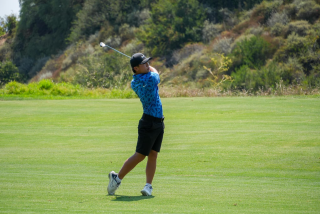GOLF IN THE ‘90S : Santa Monica Company Has Yen for Buying Golf Operations : Business: American Golf owns and operates 140 U.S. courses, including several in the county.
- Share via
During the most recent golf-course buying frenzy, foreign investors were pursuing every opportunity to purchase established courses in the United States. Some were even pursuing non-opportunities.
“I was getting one or two inquiries every week from the Japanese about Anaheim Hills,” said Don Marshall, director of golf operations for Anaheim. “They asked me if I was interested in selling my golf course. They told me money was no object. I had trouble explaining it wasn’t my golf course.
“It’s died down now. I guess they’ve finally realized that municipal courses can’t just be bought.”
The money-is-no-object approach of some potential buyers has helped to send the price of courses spiraling in recent years. But foreign interests have run into some red-white-and-blue competition, from a Santa Monica-based firm aptly named American Golf Corp.
American Golf now owns and operates 140 U.S. courses, including Casta del Sol Public Golf Course in Mission Viejo, David L. Baker Memorial Golf Center in Fountain Valley, El Toro Golf Center, Fullerton Golf Club, Meadowlark Golf Course in Huntington Beach and Rancho San Joaquin Golf Course in Irvine.
By 1996, the firm, which says it’s the largest golf course operator in the world, hopes to own 250 courses.
“We’re not really competing with the Japanese because they seem to be more interested in what we call the ‘trophy’ courses,” said Ron Johnson, American Golf’s chief executive officer. “In fact, we just sold Yorba Linda Country Club to a Japanese group.”
American Golf owns practice centers, public courses, executive courses and some private clubs. They build some facilities and buy others, but they make a habit of avoiding bidding wars.
“We’re actively seeking to buy courses, but we aren’t interested in paying any price to get them,” Johnson said. “A course has to carry the weight of the investment. I’m not sure what (some foreign investors’) criteria is. There’s a lot of talk about them selling expensive memberships in Japan, but I don’t think that’s panning out as well as they expected.
“Our objective is pretty simple. We want to provide our customers with the best product and the best quality. Hopefully, that will mean golfers in sufficient numbers will turn out to make the endeavor profitable.”
To that end, the firm hires a field of agronomists and other specialists in an effort to ensure that each American Golf facility uses the correct amount of sand, seed and fertilizer to keep its course in top condition.
Johnson, a member of the National Golf Foundation’s board of directors, is aware of the lack of affordable public courses in Southern California as well as the nationwide need for them.
He maintains, however, that nonstop construction of courses is not the only cure.
So, American Golf’s courses have implemented varying fee structures to encourage people to play at less desirable times, with incentives such as price breaks for seniors, who are often retired and can play on weekdays or in the afternoon.
“There are literally hundreds of courses around the country that are for sale because they’re going under financially,” Johnson said. “Sure, we need to build more courses, but what we need to do first is get more players into the available slots.
“You can’t build a big enough church to hold the crowd on Easter Sunday and you can’t build enough golf courses to handle all the people who want to tee off at 9 on Saturday morning.”
More to Read
Inside the business of entertainment
The Wide Shot brings you news, analysis and insights on everything from streaming wars to production — and what it all means for the future.
You may occasionally receive promotional content from the Los Angeles Times.










